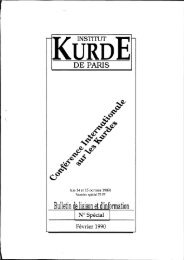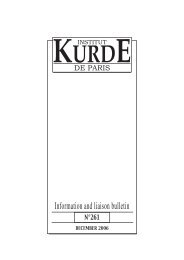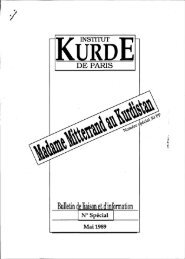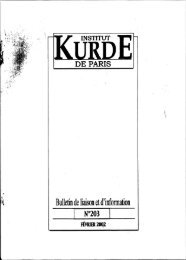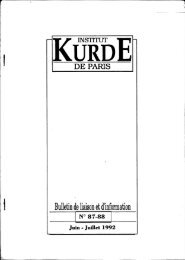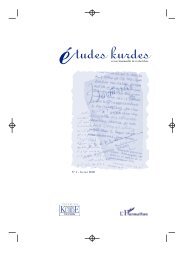Bulletin de liaison et d'information - Institut kurde de Paris
Bulletin de liaison et d'information - Institut kurde de Paris
Bulletin de liaison et d'information - Institut kurde de Paris
You also want an ePaper? Increase the reach of your titles
YUMPU automatically turns print PDFs into web optimized ePapers that Google loves.
Revue <strong>de</strong> Presse-Press Review-Berhevoka c;ape-Rivista Stampa-Dentro <strong>de</strong> la Prensa-Baszn Dz<strong>et</strong>i<br />
Iraq nearing chaos, u.s. Army says<br />
By Michael R. Gordon<br />
WASHINGTON: A classified briefing<br />
prepared two weeks ago by the u.s.<br />
Central Command portrays Iraq as<br />
edging toward chaos, in a chart that<br />
provi<strong>de</strong>s a rare glimpse of how the mi~itary<br />
command that oversees the war IS<br />
trying to measure its trajectory.<br />
A one-page sli<strong>de</strong> from an Oct. 18<br />
briefing shows how comman<strong>de</strong>rs look<br />
from behind closed doors at the sectarian<br />
bloodl<strong>et</strong>ting and i<strong>de</strong>ntifies the<br />
, trends officers regard as most telling.<br />
'A color-co<strong>de</strong>d bar chart used to illustrate<br />
an "In<strong>de</strong>x of Civil Conflict"<br />
shows a sharp escalation in sectarian<br />
violence since the bombing of a Shiite<br />
shrine in Samarra in February, and<br />
tracks a further worsening this month<br />
<strong>de</strong>spite a concerted American push to<br />
tamp down the violence in Baghdad.<br />
The in<strong>de</strong>x represents an effort by the<br />
Central Command's intelligence directorate<br />
to assess the intensity of the sectarian<br />
strife and its potential to <strong>de</strong>volve<br />
into a violent free-for-all. The factors<br />
. the intelligence officials are weighing<br />
inclu<strong>de</strong> indicators like the problem of<br />
ineffectual Iraqi police and the dwindling<br />
influence of mo<strong>de</strong>rate religious<br />
and political figures, rather than such<br />
traditional military measures as the capability<br />
of enemy units or territory<br />
controlled.<br />
The conclusions the Central Command<br />
has drawn from these trends are<br />
not encouraging, according to a copy of<br />
,,'<br />
Iraqi police have been a significant<br />
problem and cites as a concern sectarian<br />
Lonflicts b<strong>et</strong>ween Iraqi security<br />
forces.<br />
Other significant factors are in the<br />
political realm. One sli<strong>de</strong> notes that the<br />
Iraq's political and religious lea<strong>de</strong>rs<br />
have lost some of their mo<strong>de</strong>rating inthe<br />
sli<strong>de</strong> from the brief that was obtained<br />
by The New York Times. The<br />
sli<strong>de</strong> shows Iraq as moving sharply<br />
away from "peace," an i<strong>de</strong>al on the far<br />
left si<strong>de</strong> of the chart, to a point much<br />
closer to the opposite end of the spectrum.<br />
As <strong>de</strong>picted in the command's<br />
chart, the needle has been moving<br />
steadily toward the far right of the<br />
chart, a red zone marked "chaos."<br />
An intelligence summary at the bottom<br />
of the sli<strong>de</strong> reports "Urban areas<br />
experiencing '<strong>et</strong>hnic cleansing' campaigns<br />
to consolidate control" and "violence<br />
at all-time high, spreading geographically."<br />
According. to a Cen~r~l<br />
Command official, the m<strong>de</strong>x on CIvil<br />
strife has been a staple of internal command<br />
briefings for most of this year.<br />
The analysis is prepared by the co.mmand's<br />
intelligence directorate, whIch<br />
is overseen by Brigadier General John<br />
Custer.<br />
General John Abizaid, who heads the<br />
command, warned publicly in August<br />
about the risk of civil war in Iraq but<br />
said then that he thought it could be<br />
averted. In evaluating th~ prospects for<br />
all-out civil strife, the command concentrates<br />
on several principal variables<br />
- what the briefing refers to as "key<br />
reads." According to the sli<strong>de</strong> from the<br />
Oct. 18 briefing, they inclu<strong>de</strong> "hostile<br />
rh<strong>et</strong>oric" by political and religious lead-<br />
I<br />
ers, which can be measured by listening<br />
to the sermons at mosques and important<br />
Shiite and Sunni lea<strong>de</strong>rs, and the<br />
amount of influence that mo<strong>de</strong>rate<br />
political and religious figures h~ve ovt;r<br />
the population. The other mam vanabIes<br />
are assassinations and other especially<br />
provocative sectarian a~t~cks as<br />
well as "spontaneous mass CIvil conflict."<br />
A number of secondary indicators<br />
are also taken into account, including<br />
activity by militias, problems wit~ ine~fective<br />
police, the ability of IraqI offIcials<br />
to govern effectively, the number<br />
civilians who have been forced to move<br />
by sectarian violence, the willingness<br />
of Iraqi security forces ~ofollow ord.ers<br />
and Kurdish separatIst ten<strong>de</strong>nCIes,<br />
among other factors.<br />
These factors are evaluated to create<br />
the in<strong>de</strong>x of civil strife, which has been<br />
steadily on the worrisome si<strong>de</strong> of the<br />
spectrum for months. "r:~er since t~e<br />
February attack on .he Shute mosque m<br />
Samarra, it has been closer to the chaos<br />
si<strong>de</strong> than the peace si<strong>de</strong>," said a Central<br />
Command official who asked not to be<br />
i<strong>de</strong>ntified because he was talking about<br />
classified information.<br />
In the Oct. 18 brief the in<strong>de</strong>x moved<br />
still another notch toward "chaos."<br />
That briefing was prepared three days<br />
before Abizaid r<strong>et</strong>urned to Washington<br />
to me<strong>et</strong> with Presi<strong>de</strong>nt George W. Bush,<br />
Defense Secr<strong>et</strong>ary Donald Rumsfeld<br />
and General P<strong>et</strong>er Pace, chairman of<br />
the Joint Chiefs of Staff, for their stocktaking<br />
on Iraq.<br />
A spokesman for the Central Command<br />
<strong>de</strong>clined to comment on the in<strong>de</strong>x<br />
or other information in the sli<strong>de</strong>.<br />
"We don't comment on secr<strong>et</strong> material,"<br />
the spokesman said.<br />
One significant factor in the military's<br />
<strong>de</strong>cision to move the scale toward<br />
"chaos" was the expanding activity by<br />
militias.<br />
Another reason was the limitations<br />
of Iraqi government security forces,<br />
which <strong>de</strong>spite years of training and<br />
equipping by the United States, are<br />
either ineffective or in some cases infiltrated<br />
by the very militias they are<br />
supposed to be combating.<br />
The sli<strong>de</strong> notes that "ineffectual"<br />
u.s. FORCESBACKOFF - Resi<strong>de</strong>nts of<br />
Baghdad's Sadr City chanting slogans<br />
Tuesday after U.S.troops abandoned<br />
roadblocks. Prime Minister Nuri Kamal<br />
al-Maliki or<strong>de</strong>red the lifting of joint<br />
U.S.-Iraqimilitary checkpoints around<br />
the Shiite militant stronghold in another<br />
apparent mO¥<strong>et</strong>o assert his authority<br />
with the Americans and appeal to his<br />
Shiite base ~f support. - -<br />
In<strong>de</strong>x of civil conflict (assessed)<br />
Peace<br />
Source<br />
U S Central Command<br />
t<br />
Pre-~amarra<br />
. ,. .,f.'J't'"<br />
',~ -::"'{.."r.~t<br />
tt<br />
'> : ~ i' "Mf~".p.~<br />
Chaos<br />
Last week Current<br />
IHT<br />
3





